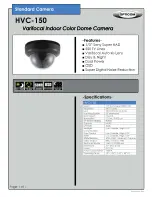12
PL-A780 Camera Specifications
Document No.: 04646-01
PixeLINK PL-A780
MACHINE VISION CAMERA
SYSTEM GUIDE
Copyright © 2004 PixeLINK
All Rights Reserved
preview at high frame rates with short exposure times, use the decimation mode. For slower,
high quality video preview or when exposure times are long, use resampling.
3.2.2 Bit Depth
The analog image data from the sensor is digitized to 12-bits and then truncated to 10-bits
prior to image processing in the camera electronics. Full gain and offset corrections are
performed along with pixel correction to eliminate fixed pattern noise (FPN) and Photo
Response Non Uniformity (PRNU). On color cameras, color corrections are performed to
convert sensor RGB to calibrated RGB for accurate color reproduction. The output data
stream can be set to either 8-bit or 10-bit mode. In 10-bit mode, the 10-bit data is padded
with zeros in the least significant bits to create 16-bit words. Compared to the 8-bit mode, the
10-bit mode requires twice the bandwidth on the FireWire bus and will result in a drop in
frame rate.
3.2.3 Timing, Performance and Data Rates
The PL-A780 sensor uses a 40 MHz pixel clock to read out pixel data at 25 nanoseconds per
pixel. Each row also has a delay of 7.3 µseconds and is padded with 10 isolation pixels. The
minimum row readout time, in microseconds, is given by
1000
/
)
10
(
25
3
.
7
)
(
+
∗
+
=
Npixels
ns
µs
µs
outTime
MinRowread
where
Npixels
is the number of active pixels in the row. For the full ROI, the row readout time
is 7.3+25*(2208+10)/1000 = 62.75 µs/row.
For Rolling Shutter operation (see Section 3.2.4 below) with very short exposures, the
minimum frame interval can be calculated by multiplying the minimum row readout time by
the number of rows in the image. For example, with a 1200 x 960 ROI, decimated by 2, the
output image would be 600 x 480. This ROI could be readout once every 480*(7.3
+25*600/1000)/1000 = 10.7 milliseconds or at a maximum frame rate of 93.4 frames per
second. In this example, the maximum frame rate is valid for exposures of 10.7 milliseconds
or less. For exposures greater than 10.7 milliseconds, the frame rate is a function of the
exposure time.
For Fast Reset Shutter operation (see Section 3.2.4 below), the minimum frame interval can
be found by adding together the row reset time of 3.55 µseconds/row, the integration time
and the minimum row readout time calculated above. Using the example above and
assuming a 2 millisecond exposure time, the minimum frame interval is 10.7 + 2 +
3.55*480/1000 = 14.40 milliseconds which gives a maximum frame rate of 69.5 frames per
second.
The above calculations determine the maximum frame rates possible. The actual frame
rates achieved depend on the camera’s bandwidth controls, other traffic on the FireWire bus,
and the resources available on the host computer.
3.2.4 Operating Modes - Rolling Shutter and Fast Reset Shutter
The PL-A780 has two shutter types:
•
Rolling Shutter (free-running image capture activated when the trigger feature
is turned off); and
•
Fast Reset Shutter (triggered image capture activated when the trigger feature
is turned on)


















